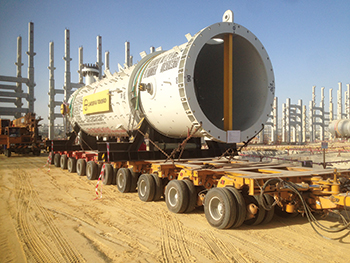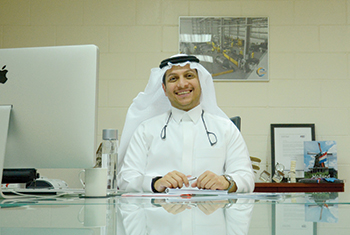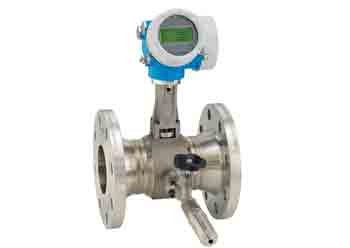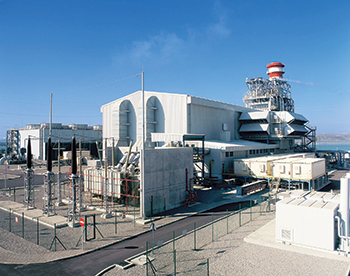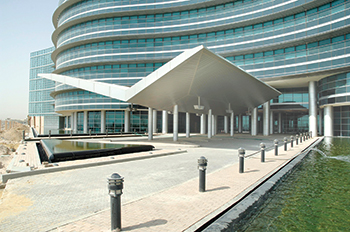
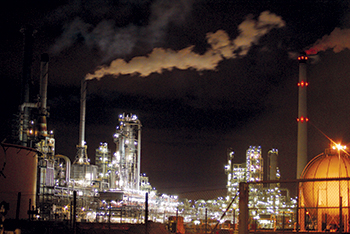 Kuwait is investing heavily in the oil and gas sector
Kuwait is investing heavily in the oil and gas sector
Kuwait Petroleum Corporation plans to spend $114 billion in capital expenditure over the next five years and an additional $394 billion beyond that to 2040
Kuwait plans to spend $500 billion by 2040 to boost its oil and gas output and refining capacity even as it aims to carry out a number of major projects to boost oil production to 4.75 million barrels per day (mbpd).
'To achieve these targets, Kuwait’s national oil company, Kuwait Petroleum Corporation (KPC) plans to spend $114 billion in capital expenditure over the next five years and an additional $394 billion beyond that to 2040,' the chief executive officer of KPC Nizar Al Adsani says.
'KPC has launched the 2040 strategy which focuses on growth in all its activities that require significant funds to finance the mega projects,' he says.
Adsani notes that the energy industry faces complex and diverse challenges, but dealing with it professionally focuses on the strategy of investment, innovation and cooperation.
'KPC is working with fast-changing variables and challenges locally and internationally, and we continue to focus on strategies that will transform Kuwait into a better position to deal with future challenges,' he says.
Kuwait currently has a crude production capacity of around 3.1 mbpd, excluding some 250,000 bpd from the neutral zone with Saudi Arabia which has remained shut since October 2014. It plans to raise its output capacity to 4 mbpd by 2020. Adsani says the firm also plans to raise free natural gas production to 2.5 billion cubic feet a day (bcfd) by 2040 from just 200 million cubic feet a day currently. Free gas production will reach half a billion cubic feet in April and one billion cubic feet in 2023, he says.
Kuwait also produces about 1.2 bcfd of associated gas, which is produced along with crude oil. The state plans to raise its refining capacity to 2 mbpd by 2035 from less than 800,000 bpd now, Adsani says. Around 90 per cent of Kuwait’s state revenues come from oil. Kuwait amassed around $600 billion in surpluses in the 16 years till 2014, when world prices were high.
 |
Al Rashidi ... boosting capacity |
Kuwait’s oil production capacity will reach 3.255 mbpd by the end of next March, Kuwait’s Oil Minister and Minister of Electricity and Water Bakheet Al-Rashidi says.
Al-Rashidi says in an interview that the volume of Kuwaiti exports of crude oil is about 2.1 mbpd, while the daily production volume is about 2.7 mbpd in line with the agreement to cut production between the Organization of Petroleum Exporting Countries (Opec) and producers from outside the group. He says that the producers’ agreement from within and outside Opec to reduce production, which came into force in January 2017, contributed to the efforts to restore the balance of markets, which reflected positively on oil prices, which rose in the past period following improvement in the balance of demand and supply in the markets.
He explains that the agreement proved effective in controlling the balance of demand and supply in order to achieve balance in the markets, stressing that the fundamentals of the market will be reviewed at the Ministerial Conference of (Opec) in June.
He points out that the recent decision on the extension of the agreement to reduce production until the end of this year will achieve the balance required by the end of next year amid an obvious recovery in the basic market factors associated with supply and demand.
Al-Rashidi points out that oil prices are affected by a combination of factors, most notably the recovery of growth rate of demand, improving the rate of growth of the global economy and the geopolitical and technical developments, which affect production of some countries.
On the current oil prices, he says that 'there is no specific fair price' because it changes permanently according to market conditions, as the price level reflects the state of the oil market, noting that the state of improving the fundamentals of the oil market will strengthen prices levels in the coming months.
With regard to the impact of US rock oil at price levels, he said that increased production led to imbalance of the market with the increase in supply, which contributed to the weakness of crude oil prices in previous years and other factors, pointing out that there are expectations of continued increase in rock oil production in the coming months.
On KPC’s new strategy of producing 4.750 mbpd by 2040, he says that the KPC has translated its strategic directions into a roadmap to ensure its achievement and supports Kuwait’s domestic and international role as a reliable source of energy security.
He points to the need to invest in exploration and development of production, including the development of heavy and light oil production to achieve the goals set to raise the production capacity of Kuwaiti crude oil.
Al-Rashidi says that the strategy of the oil sector is always working to raise the volume of proved reserves through exploration operations and increase oil extraction rates.
On the impact of Kuwait’s oil projects on the fluctuation of oil prices, he points out that they are strategic long-term and diversified projects covering all oil fields, stressing that the KPC is continuing to implement them regardless of fluctuating prices.
On the importance of the project of environmental fuel and Al-Zour refinery at the moment, he stresses that they are environmentally strategic projects aimed at protecting the environment and meet the local and global needs in accordance with the highest standards for the specifications of petroleum products.
He points out that the environmental fuel project aims to produce an environmentally-clean Kuwaiti production in line with global demand patterns in the markets as well as maintaining the country’s markets and securing new markets, noting that the completion rates in the project is 90 per cent and is expected to be completed by the end of this year.
 |
Adsani ... effective leadership |
The oil minister says that Al-Zour refinery project will be completed in 2019, as nearly 45 per cent has so far been achieved.
On petrochemicals industry, he says that Kuwait has a pioneering experience in this industry, which is receiving increasing attention in the KPC’ strategy, pointing to existing projects in the field of aromatics and olefins inside and outside the country, as well as the existence of many investment opportunities under study.
He says the strategy of KPC is based on the principle of complementarity between the various activities carried out by the oil and gas industry in Kuwait, which starts from production and ends at the delivery to customers, a strategy that ensures protection against fluctuations in oil prices and maximize the added value of Kuwaiti crude oil.
Kuwait has set itself a higher long term oil production capacity target despite headwinds achieving its nearer term capacity goals due to a long-running dispute over the control of fields shared with Saudi Arabia.
Industry sources in Kuwait have been skeptical about the government’s ability to reach the long held 4 mbpd target by 2020 without more help from international oil companies.
The sector has been plagued by delays to projects due to the country’s tense political environment and the 4 mbpd plan has been seen as somewhat of a moving target.
Senior KPC and oil ministry sources, however, have expressed their confidence in reaching it with new light crudes already coming online.
'The oil sector now is under a different kind of much more effective leadership,' one KPC source says.
For now KPC and its upstream subsidiary, Kuwait Oil Company (KOC) are focused on meeting Kuwait’s near-term target of raising production capacity to 4 mbpd by 2020.
Under the plan, KOC will have to contribute 3.65 mbpd of the target, with the remainder coming from Kuwait’s share of the Partitioned Neutral Zone shared with Saudi Arabia.
Sources in Kuwait have previously said KPC’s management was considering a number of options on how to meet its targets, if Kuwait is unable to restart production from the PNZ.
The combined 500,000 bpd output from its two main fields, Wafra and Khafji, has been shut-in for the last few years due to a political dispute with Riyadh. If they remain closed in the longer term, KPC will have to rely more heavily on KOC.
Even getting to 3.65 mbpd has proved a challenge for KOC, and the target date has repeatedly been pushed back.
The company has worked hard to maintain production at its giant workhorse oil field Burgan, which has been in operation since 1946.
Despite its age, the field remains the largest single contributor to the country’s oil output, accounting for more than 50 per cent of all oil produced. KOC is also trying to add around 700,000 bpd of capacity, while also replacing natural declines at other fields.
Northern Kuwait is where the main capacity increases are expected to come from. It currently produces around 1 mbpd, out of the country’s 2.7 mbpd total output.
KOC has launched new production facilities at the West Al-Rawdatain, Umm Niga and Al-Sabriya oil fields, which will add a total of 200,000 bpd of light crude. Over the last year, Kuwait has started production at a 15,000 bpd heavy oil processing plant from its northern fields. KOC hopes to reach heavy oil production of 85,000 bpd in 2018.
KPC also plans to grow its downstream refining sector to 2 mbpd by 2035, Adsani says.
Kuwait’s three existing refineries Mina Al-Ahmadi, Mina Abdullah, and Shuaiba are operated by the Kuwait National Petroleum Company and have a combined capacity of 936,000 bpd.
Kuwait is set to launch its newest refinery, the 615,000 bpd Al-Zour complex, in 2020, which will take total domestic refining capacity to almost 1.4 mbpd.
KPC, through subsidiary Kuwait Petroleum International, also has significant overseas refining assets.
Vietnam’s new 200,000 bpd Nghi Son refinery, in which KPI has a 35 per cent stake, will start operations this year. Construction is also underway at another 230,000 bpd Duqm joint venture refinery in Oman.
Kuwait has announced major investment in both downstream and LNG import capacity. We see downside risk to these projects being completed on time as a result of continued political challenges.
Kuwait has three major refining facilities with a total capacity of 936,000 bpd. Through a series of upgrading and expansion projects, the refineries, which are in close proximity, have been partially integrated in order to allow for flexibility in the manufacturing and marketing of products.
As part of a major overhaul of the downstream sector, known as the Clean Fuels Project, the 200,000 bpd Shuaiba refinery was shut in 2017. The 270,000 bpd Mina Abdullah and 466,000 bpd Mina Al-Ahmadi facilities will be integrated and upgraded, while a new 550,000 bpd greenfield facility know as Al-Zour is to be constructed, raising total capacity to 1.4 mbpd.
Mina Al-Ahmadi is the country’s largest refinery, with a capacity of 466,000 bpd, and is located about 45 km south of Kuwait City. The facility was built in 1949 and has undergone a series of upgrades, including a modernisation project in 1984 and a further upgrading project in 1986.
The upgrades were focused on increasing the share of light and medium products produced during the distillation process. As a result, the refinery provides low-sulphur petroleum products.










































































